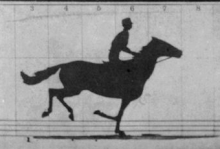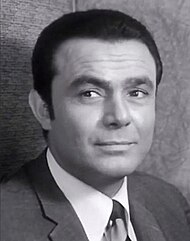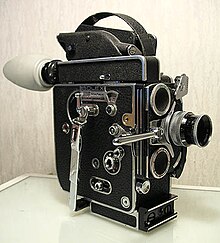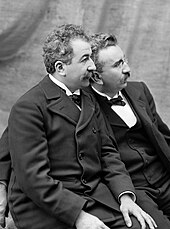Film
This article needs additional citations for verification. (June 2019) |
| Part of a series on |
| Filmmaking |
|---|
 |
| Glossary |
A film – also called a movie, motion picture, moving picture, picture, photoplay or (slang) flick – is a work of
Recording and transmission of the film
The moving images of a film are created by photographing actual scenes with a motion-picture camera, by photographing drawings or miniature models using traditional animation techniques, by means of CGI and computer animation, or by a combination of some or all of these techniques, and other visual effects.
Before the introduction of digital production, a series of still images were recorded on a strip of chemically sensitized celluloid (
Contemporary films are usually fully digital through the entire process of production, distribution, and exhibition.
Etymology and alternative terms
The name "film" originally referred to the thin layer of photochemical emulsion
Many other terms exist for an individual motion-picture, including "picture", "picture show", "moving picture", "photoplay", and "flick". The most common term in the United States is "movie", while in Europe, "film" is preferred. Archaic terms include "animated pictures" and "animated photography".
"Flick" is, in general a slang term, first recorded in 1926. It originates in the verb flicker, owing to the flickering appearance of early films.[3]
Common terms for the field, in general, include "the big screen", "the silver screen", "the movies", and "cinema"; the last of these is commonly used, as an overarching term, in scholarly texts and critical essays. In the early years, the word "sheet" was sometimes used instead of "screen".
History
Precursors
The art of film has drawn on several earlier traditions in fields such as oral
- shadowgraphy, probably used since prehistoric times
- camera obscura, a natural phenomenon that has possibly been used as an artistic aid since prehistoric times
- shadow puppetry, possibly originated around 200 BCE in Central Asia, India, Indonesia or China
- The magic lantern, developed in the 1650s. The multi-media phantasmagoria shows that magic lanterns were popular from 1790 throughout the first half of the 19th century and could feature mechanical slides, rear projection, mobile projectors, superimposition, dissolving views, live actors, smoke (sometimes to project images upon), odors, sounds and even electric shocks.
Before celluloid

The stroboscopic animation principle was introduced in 1833 with the stroboscopic disc (better known as the phénakisticope) and later applied in the zoetrope (since 1866), the flip book (since 1868), and the praxinoscope (since 1877), before it became the basic principle for cinematography.
Experiments with early phénakisticope-based animation projectors were made at least as early as 1843 and publicly screened in 1847. Jules Duboscq marketed phénakisticope projection systems in France from c. 1853 until the 1890s.
Photography was introduced in 1839, but initially photographic emulsions needed such long exposures that the recording of moving subjects seemed impossible. At least as early as 1844, photographic series of subjects posed in different positions were created to either suggest a motion sequence or document a range of different viewing angles. The advent of stereoscopic photography, with early experiments in the 1840s and commercial success since the early 1850s, raised interest in completing the photographic medium with the addition of means to capture colour and motion. In 1849, Joseph Plateau published about the idea to combine his invention of the phénakisticope with the stereoscope, as suggested to him by stereoscope inventor Charles Wheatstone, and to use photographs of plaster sculptures in different positions to be animated in the combined device. In 1852, Jules Duboscq patented such an instrument as the "Stéréoscope-fantascope, ou Bïoscope", but he only marketed it very briefly, without success. One Bïoscope disc with stereoscopic photographs of a machine is in the Plateau collection of Ghent University, but no instruments or other discs have yet been found.

By the late 1850s the first examples of

Émile Reynaud already mentioned the possibility of projecting the images of the Praxinoscope in his 1877 patent application. He presented a praxinoscope projection device at the Société française de photographie on 4 June 1880, but did not market his praxinoscope a projection before 1882. He then further developed the device into the Théâtre Optique which could project longer sequences with separate backgrounds, patented in 1888. He created several movies for the machine by painting images on hundreds of gelatin plates that were mounted into cardboard frames and attached to a cloth band. From 28 October 1892 to March 1900 Reynaud gave over 12,800 shows to a total of over 500,000 visitors at the Musée Grévin in Paris.
First motion pictures

By the end of the 1880s, the introduction of lengths of celluloid photographic film and the invention of motion picture cameras, which could photograph a rapid sequence of images using only one lens, allowed action to be captured and stored on a single compact reel of film.
Movies were initially shown publicly to one person at a time through "peep show" devices such as the Electrotachyscope, Kinetoscope and the Mutoscope. Not much later, exhibitors managed to project films on large screens for theatre audiences.
The first public screenings of films at which admission was charged were made in 1895 by the American Woodville Latham and his sons, using films produced by their Eidoloscope company,[7] by the Skladanowsky brothers and by the – arguably better known – French brothers Auguste and Louis Lumière with ten of their own productions.[citation needed] Private screenings had preceded these by several months, with Latham's slightly predating the others´s.[citation needed]
Early evolution
The earliest films were simply one static
The rise of European cinema was interrupted by the outbreak of
Sound
In the 1920s, the development of electronic
The evolution of sound in cinema began with the idea of combining moving images with existing phonograph sound technology. Early sound-film systems, such as Thomas Edison's Kinetoscope and the Vitaphone used by Warner Bros., laid the groundwork for synchronized sound in film. The Vitaphone system, produced alongside Bell Telephone Company and Western Electric, faced initial resistance due to expensive equipping costs, but sound in cinema gained acceptance with movies like Don Juan (1926) and The Jazz Singer (1927).[8]
American film studios, while Europe standardized on Tobis-Klangfilm and Tri-Ergon systems. This new technology allowed for greater fluidity in film, giving rise to more complex and epic movies like King Kong (1933).[9]
As the television threat emerged in the 1940s and 1950s, the film industry needed to innovate to attract audiences. In terms of sound technology, this meant the development of surround sound and more sophisticated audio systems, such as Cinerama's seven-channel system. However, these advances required a large number of personnel to operate the equipment and maintain the sound experience in theaters.[9]
In 1966,
Today, the future of sound in film remains uncertain, with potential influences from artificial intelligence, remastered audio, and personal viewing experiences shaping its development.[11][12] However, it is clear that the evolution of sound in cinema has been marked by continuous innovation and a desire to create more immersive and engaging experiences for audiences.
Color
A significant technological advancement in film was the introduction of "natural color," where color was captured directly from nature through photography, as opposed to being manually added to black-and-white prints using techniques like hand-coloring or stencil-coloring.[13][14] Early color processes often produced colors that appeared far from "natural".[15] Unlike the rapid transition from silent films to sound films, color's replacement of black-and-white happened more gradually.[16]
The crucial innovation was the three-strip version of the Technicolor process, first used in animated cartoons in 1932.[17][18] The process was later applied to live-action short films, specific sequences in feature films, and finally, for an entire feature film, Becky Sharp, in 1935.[19] Although the process was expensive, the positive public response, as evidenced by increased box office revenue, generally justified the additional cost.[13] Consequently, the number of films made in color gradually increased year after year.[20][21]
1950s: growing influence of television
In the early 1950s, the proliferation of black-and-white television started seriously depressing North American theater attendance.[citation needed] In an attempt to lure audiences back into theaters, bigger screens were installed, widescreen processes, polarized 3D projection, and stereophonic sound were introduced, and more films were made in color, which soon became the rule rather than the exception. Some important mainstream Hollywood films were still being made in black-and-white as late as the mid-1960s, but they marked the end of an era. Color television receivers had been available in the US since the mid-1950s, but at first, they were very expensive and few broadcasts were in color. During the 1960s, prices gradually came down, color broadcasts became common, and sales boomed. The overwhelming public verdict in favor of color was clear. After the final flurry of black-and-white films had been released in mid-decade, all Hollywood studio productions were filmed in color, with the usual exceptions made only at the insistence of "star" filmmakers such as Peter Bogdanovich and Martin Scorsese.[citation needed]
1960s and later

The decades following the decline of the
Film theory

"
Language
Film is considered to have its own language. James Monaco wrote a classic text on film theory, titled "How to Read a Film," that addresses this. Director Ingmar Bergman famously said, "Andrei Tarkovsky for me is the greatest director, the one who invented a new language, true to the nature of film, as it captures life as a reflection, life as a dream." An example of the language is a sequence of back and forth images of one speaking actor's left profile, followed by another speaking actor's right profile, then a repetition of this, which is a language understood by the audience to indicate a conversation. This describes another theory of film, the 180-degree rule, as a visual story-telling device with an ability to place a viewer in a context of being psychologically present through the use of visual composition and editing. The "Hollywood style" includes this narrative theory, due to the overwhelming practice of the rule by movie studios based in Hollywood, California, during film's classical era. Another example of cinematic language is having a shot that zooms in on the forehead of an actor with an expression of silent reflection that cuts to a shot of a younger actor who vaguely resembles the first actor, indicating that the first person is remembering a past self, an edit of compositions that causes a time transition.
Montage
The concept of montage emerged in the 1920s, with pioneering Soviet filmmakers such as Sergei Eisenstein and Lev Kuleshov developing the theory of montage. Eisenstein's film Battleship Potemkin (1925) is a prime example of the innovative use of montage, where he employed complex juxtapositions of images to create a visceral impact on the audience.[23]
As the art of montage evolved, filmmakers began incorporating musical and visual counterpoint to create a more dynamic and engaging experience for the viewer. The development of scene construction through mise-en-scène, editing, and special effects led to more sophisticated techniques that can be compared to those utilized in opera and ballet.[24]
The French New Wave movement of the late 1950s and 1960s also embraced the montage technique, with filmmakers such as Jean-Luc Godard and François Truffaut using montage to create distinctive and innovative films. This approach continues to be influential in contemporary cinema, with directors employing montage to create memorable sequences in their films.[25]
In contemporary cinema, montage continues to play an essential role in shaping narratives and creating emotional resonance. Filmmakers have adapted the traditional montage technique to suit the evolving aesthetics and storytelling styles of modern cinema.
- Rapid editing and fast-paced montages: With the advent of digital editing tools, filmmakers can now create rapid and intricate montages to convey information or emotions quickly. Films like Darren Aronofsky's Requiem for a Dream (2000) and Edgar Wright's Shaun of the Dead (2004) employ fast-paced editing techniques to create immersive and intense experiences for the audience.[24]
- Music video influence: The influence of music videos on film has led to the incorporation of stylized montage sequences, often accompanied by popular music. Films like Guardians of the Galaxy (2014) and Baby Driver (2017) use montage to create visually striking sequences that are both entertaining and narratively functional.[26]
- Sports and training montages: The sports and training montage has become a staple in modern cinema, often used to condense time and show a character's growth or development. Examples of this can be found in films like Rocky (1976), The Karate Kid (1984), and Million Dollar Baby (2004).[27]
- Cross-cutting and parallel action: Contemporary filmmakers often use montage to create tension and suspense by cross-cutting between parallel storylines. Christopher Nolan's Inception (2010) and Dunkirk (2017) employ complex cross-cutting techniques to build narrative momentum and heighten the audience's emotional engagement.[28]
- Thematic montage: Montage can also be used to convey thematic elements or motifs in a film. Wes Anderson's The Royal Tenenbaums (2001) employs montage to create a visual language that reflects the film's themes of family, nostalgia, and loss.[29]
As the medium of film continues to evolve, montage remains an integral aspect of visual storytelling, with filmmakers finding new and innovative ways to employ this powerful technique.
Film criticism
If a movie can illuminate the lives of other people who share this planet with us and show us not only how different they are but, how even so, they share the same dreams and hurts, then it deserves to be called great.
— Roger Ebert (1986)[30]
Film criticism is the analysis and evaluation of films. In general, these works can be divided into two categories: academic criticism by film scholars and journalistic film criticism that appears regularly in
The impact of a reviewer on a given film's
Industry
| World cinema |
|---|
|


The making and showing of motion pictures became a source of profit almost as soon as the process was invented. Upon seeing how successful their new invention, and its product, was in their native France, the
In the United States, much of the film industry is centered around
Profit is a key force in the industry, due to the costly and risky nature of filmmaking; many films have large
Associated fields
Derivative academic fields of study may both interact with and develop independently of filmmaking, as in
Terminology
The terminology used for describing motion pictures varies considerably between
By contrast, in the United States, movie is the predominant term for the medium. Although the words film and movie are sometimes used interchangeably, film is more often used when considering
Further terminology is used to distinguish various forms and media used in the film industry. Motion pictures and moving pictures are frequently used terms for film and movie productions specifically intended for theatrical exhibition, such as
In US usage, one talks of a
A
Any film may also have a sequel, which portrays events following those in the film. Bride of Frankenstein is an early example. When there are more films than one with the same characters, story arcs, or subject themes, these movies become a series, such as the James Bond series. Existing outside a specific story timeline usually does not exclude a film from being part of a series. A film that portrays events occurring earlier in a timeline with those in another film, but is released after that film, is sometimes called a prequel, an example being Butch and Sundance: The Early Days.
The credits, or end credits, are a list that gives credit to the people involved in the production of a film. Films from before the 1970s usually start a film with credits, often ending with only a title card, saying "The End" or some equivalent, often an equivalent that depends on the language of the production.[citation needed] From then onward, a film's credits usually appear at the end of most films. However, films with credits that end a film often repeat some credits at or near the start of a film and therefore appear twice, such as that film's acting leads, while less frequently some appearing near or at the beginning only appear there, not at the end, which often happens to the director's credit. The credits appearing at or near the beginning of a film are usually called titles or beginning titles. A post-credits scene is a scene shown after the end of the credits. Ferris Bueller's Day Off has a post-credits scene in which Ferris tells the audience that the film is over and they should go home.
A film's cast refers to a collection of the actors and actresses who appear, or star, in a film. A star is an actor or actress, often a popular one, and in many cases, a celebrity who plays a central character in a film. Occasionally the word can also be used to refer to the fame of other members of the crew, such as a director or other personality, such as Martin Scorsese. A crew is usually interpreted as the people involved in a film's physical construction outside cast participation, and it could include directors, film editors, photographers, grips, gaffers, set decorators, prop masters, and costume designers. A person can both be part of a film's cast and crew, such as Woody Allen, who directed and starred in Take the Money and Run.
A film goer, movie goer, or film buff is a person who likes or often attends films and movies, and any of these, though more often the latter, could also see oneself as a student to films and movies or the filmic process. Intense interest in films, film theory, and film criticism, is known as cinephilia. A film enthusiast is known as a cinephile or cineaste.
Preview
Preview performance refers to a showing of a film to a select audience, usually for the purposes of corporate promotions, before the public film premiere itself. Previews are sometimes used to judge audience reaction, which if unexpectedly negative, may result in recutting or even refilming certain sections based on the audience response. One example of a film that was changed after a negative response from the test screening is 1982's First Blood. After the test audience responded very negatively to the death of protagonist John Rambo, a Vietnam veteran, at the end of the film, the company wrote and re-shot a new ending in which the character survives.[38]
Trailers or previews are advertisements for films that will be shown in 1 to 3 months at a cinema. Back in the early days of cinema, with theaters that had only one or two screens, only certain trailers were shown for the films that were going to be shown there. Later, when theaters added more screens or new theaters were built with a lot of screens, all different trailers were shown even if they were not going to play that film in that theater. Film studios realized that the more trailers that were shown (even if it was not going to be shown in that particular theater) the more patrons would go to a different theater to see the film when it came out. The term trailer comes from their having originally been shown at the end of a film program. That practice did not last long because patrons tended to leave the theater after the films ended, but the name has stuck. Trailers are now shown before the film (or the "A film" in a double feature program) begins. Film trailers are also common on DVDs and Blu-ray Discs, as well as on the Internet and mobile devices. Trailers are created to be engaging and interesting for viewers. As a result, in the Internet era, viewers often seek out trailers to watch them. Of the ten billion videos watched online annually in 2008, film trailers ranked third, after news and user-created videos.[39] A teaser is a much shorter preview or advertisement that lasts only 10 to 30 seconds. Teasers are used to get patrons excited about a film coming out in the next six to twelve months. Teasers may be produced even before the film production is completed.
The role of film in culture

Films are
Education and propaganda
Film is used for a range of goals, including education and propaganda due its ability to effectively intercultural dialogue. When the purpose is primarily educational, a film is called an "educational film". Examples are recordings of academic lectures and experiments, or a film based on a classic novel. Film may be propaganda, in whole or in part, such as the films made by Leni Riefenstahl in Nazi Germany, US war film trailers during World War II, or artistic films made under Stalin by Sergei Eisenstein. They may also be works of political protest, as in the films of Andrzej Wajda, or more subtly, the films of Andrei Tarkovsky. The same film may be considered educational by some, and propaganda by others as the categorization of a film can be subjective.
Production
At its core, the means to produce a film depend on the content the filmmaker wishes to show, and the apparatus for displaying it: the zoetrope merely requires a series of images on a strip of paper. Film production can, therefore, take as little as one person with a camera (or even without a camera, as in Stan Brakhage's 1963 film Mothlight), or thousands of actors, extras, and crew members for a live-action, feature-length epic. The necessary steps for almost any film can be boiled down to conception, planning, execution, revision, and distribution. The more involved the production, the more significant each of the steps becomes. In a typical
This production cycle usually takes three years. The first year is taken up with development. The second year comprises preproduction and production. The third year, post-production and distribution. The bigger the production, the more resources it takes, and the more important financing becomes; most feature films are artistic works from the creators' perspective (e.g., film director, cinematographer, screenwriter) and for-profit business entities for the production companies.
Crew
A film crew is a group of people hired by a film company, employed during the "production" or "photography" phase, for the purpose of producing a film or motion picture. Crew is distinguished from cast, who are the
Technology
As a medium, film is not limited to motion pictures, since the technology developed as the basis for photography. It can be used to present a progressive sequence of still images in the form of a slideshow. Film has also been incorporated into multimedia presentations and often has importance as primary historical documentation. However, historic films have problems in terms of preservation and storage, and the motion picture industry is exploring many alternatives. Most films on cellulose nitrate base have been copied onto modern safety films. Some studios save color films through the use of separation masters: three B&W negatives each exposed through red, green, or blue filters (essentially a reverse of the Technicolor process). Digital methods have also been used to restore films, although their continued obsolescence cycle makes them (as of 2006) a poor choice for long-term preservation. Film preservation of decaying film stock is a matter of concern to both film historians and archivists and to companies interested in preserving their existing products in order to make them available to future generations (and thereby increase revenue). Preservation is generally a higher concern for nitrate and single-strip color films, due to their high decay rates; black-and-white films on safety bases and color films preserved on Technicolor imbibition prints tend to keep up much better, assuming proper handling and storage.
Some films in recent decades have been recorded using
Independent

Independent filmmaking often takes place outside Hollywood, or other major
Before the advent of
Since the introduction of digital video DV technology, the means of production have become more democratized. Filmmakers can conceivably shoot a film with a digital video camera and edit the film, create and edit the sound and music, and mix the final cut on a high-end home computer. However, while the means of production may be democratized, financing, distribution, and marketing remain difficult to accomplish outside the traditional system. Most independent filmmakers rely on film festivals to get their films noticed and sold for distribution. The arrival of internet-based video websites such as YouTube and Veoh has further changed the filmmaking landscape, enabling indie filmmakers to make their films available to the public.
Open content film
An open content film is much like an independent film, but it is produced through open collaborations; its source material is available under a
Fan film
A fan film is a film or video inspired by a film,
Distribution

Film distribution is the process through which a film is made available for viewing by an
Animation

Animation is a technique in which each frame of a film is produced individually, whether generated as a computer graphic, or by photographing a drawn image, or by repeatedly making small changes to a model unit (see claymation and stop motion), and then photographing the result with a special animation camera. When the frames are strung together and the resulting film is viewed at a speed of 16 or more frames per second, there is an illusion of continuous movement (due to the phi phenomenon). Generating such a film is very labor-intensive and tedious, though the development of computer animation has greatly sped up the process. Because animation is very time-consuming and often very expensive to produce, the majority of animation for TV and films comes from professional animation studios. However, the field of independent animation has existed at least since the 1950s, with animation being produced by independent studios (and sometimes by a single person). Several independent animation producers have gone on to enter the professional animation industry.
Limited animation is a way of increasing production and decreasing costs of animation by using "short cuts" in the animation process. This method was pioneered by UPA and popularized by Hanna-Barbera in the United States, and by Osamu Tezuka in Japan, and adapted by other studios as cartoons moved from movie theaters to television.[50] Although most animation studios are now using digital technologies in their productions, there is a specific style of animation that depends on film. Camera-less animation, made famous by film-makers like Norman McLaren, Len Lye, and Stan Brakhage, is painted and drawn directly onto pieces of film, and then run through a projector.
See also
- hybridgenre)
- Filmophile
- Lists
- Lost film
- The Movies, a simulation game about the film industry, taking place at the dawn of cinema
- Platforms
Notes
- Tribeca. Archived from the originalon September 7, 2013. Retrieved September 5, 2013.
- ^ "film | Etymology, origin and meaning of film". etymonline. Archived from the original on 2022-02-01. Retrieved 2022-02-01.
- ^ "Flick". Online Etymology Dictionary. 22 November 2014. Retrieved 11 December 2022.
- ^ a b Rossell, Deac. "The Exhibition of Moving Pictures before 1896".
- ^ Rossell, Deac. "The Anschuetz Zoetropes".
- ^ "Ottomar Anschütz, Kinogeschichte, lebender Bilder, Kino, erste-Kinovorführung, Kinovorführung, Projektion, Kinoe, Bewegungsbilder". www.ottomar-anschuetz.de. Retrieved 2020-04-19.
- ISBN 978-0-520-94058-1.
- ^ "A brief history of sound in film". National Science and Media Museum blog. 13 September 2021. Retrieved 2023-03-23.
- ^ a b Sonnenschein, David (2001). Sound Design: The Expressive Power of Music, Voice and Sound Effects in Cinema.
- ^ "The History and Science of Sound". TSDCA. Retrieved 2023-03-23.
- ^ "TrueSync – using the power of generative AI to visually dub film content". Flawless. Archived from the original on 2023-03-23. Retrieved 2023-03-23.
- ^ "Voice Cloning Software for Content Creators | Respeecher". www.respeecher.com. Retrieved 2023-03-23.
- ^ a b Bordwell, David, Thompson, Smith (2017). Film Art: An Introduction (11th ed.). New York: McGraw-Hill.
{{cite book}}: CS1 maint: multiple names: authors list (link) - ^ "davidbordwell.net : home". www.davidbordwell.net. Retrieved 2023-03-24.
- ^ Usai, Paolo (2000). Silent Cinema: An Introduction (Rev. ed.). London: BFI Publishing.
- ^ Gunning, Tom (1994). In Early Cinema: Space, Frame, Narrative, edited by Thomas Elsaesser. London: BFI Publishing. pp. 239–247.
- ^ Layton, Pierce, James, David (1998). The Dawn of Technicolor 1915–1935. NY: George Eastman Museum. pp. 9–35.
{{cite book}}: CS1 maint: multiple names: authors list (link) - ^ "The Dawn of Technicolor, 1915–1935".
- ^ Haines, Richard (1993). Technicolor Movies: The History of Dye Transfer Printing. Jefferson, NC: McFarland & Company.
- ^ Higgins, Scott (2007). Harnessing the Technicolor Rainbow: Color Design in the 1930s. Austin, TX: University of Texas Press.
- ^ "Who We Are". www.technicolor.com. Retrieved 2023-03-24.
- ^ Martino, Stierli (2015). "Montage and the Metropolis: Architecture, Modernity, and the Representation of Space". Journal of the Society of Architectural Historians. 74 (1): 6–31 – via JSTOR.
- ^ Ball, E (2018). "Sergei Eisenstein's Montage: Film Editing and the Theory of Attractions". JSTOR Daily.
- ^ a b "Film editing | motion pictures | Britannica". www.britannica.com. Retrieved 2023-03-25.
- ^ "New Wave | French film style | Britannica". www.britannica.com. Retrieved 2023-03-25.
- ^ "Read This: It's okay to hate John McCain's legacy". The A.V. Club. 2017-07-25. Retrieved 2023-03-25.
- ^ Desser, D. (2018). "Sports Film".
- ^ Abrams, S. (2017). "How Christopher Nolan's 'Dunkirk' Is Like a Silent Film". The Hollywood Reporter.
- ^ "Wes Anderson | Biography, Movies, & Facts | Britannica". www.britannica.com. Retrieved 2023-03-25.
- ^ Ebert, Roger (October 25, 1986). "Sid and Nancy". Chicago Sun-Times. Archived from the original on April 5, 2020. Retrieved May 31, 2020 – via RogerEbert.com.
- ISBN 978-1-55849-575-3. Archivedfrom the original on 2022-03-11. Retrieved 2022-01-17.
- ^ Bollywood Hots Up Archived 2008-03-07 at the Wayback Machine cnn.com. Retrieved June 23, 2007.
- ISSN 1752-1378.
- ^ "British English/American English Vocabulary". Archived from the original on 21 June 2013. Retrieved 26 June 2013.
- ^ a b "British English vs. U.S. English – film vs. movie". Straight Dope Message Board. 21 March 2006. Archived from the original on 10 January 2014. Retrieved 26 June 2013.
- ^ "Movie Terminology Glossary: W". IMDb. Archived from the original on 2010-07-22.
- ^ "Movie Terminology Glossary: F". IMDb. Archived from the original on 2010-07-22.
- ^ "'First Blood' Turns 30: Rambo's original dark end". Yahoo! Movies. 22 October 2012. Archived from the original on 17 November 2016. Retrieved 16 November 2016.
- ^ "AWFJ Opinion Poll: All About Movie Trailers". AWFJ. 2008-05-09. Archived from the original on 2013-12-03.
- ^ "Mona Zaki on Her Career's Future and Defending Women's Rights". Vogue Arabia. 2021-01-25. Retrieved 2023-11-26.
- ^ "Actress Mona Zaki and key national authorities mark "The Egyptian Girl Celebration" with UNICEF during Gouna Film Festival". www.unicef.org. Retrieved 2023-11-26.
- ISBN 978-3-0343-1646-0, archivedfrom the original on 2022-07-30, retrieved 2022-01-24
- from the original on 2022-07-30. Retrieved 2022-01-27.
- ^ "Silent Film Speed". Cinemaweb.com. 1911-12-02. Archived from the original on April 7, 2007. Retrieved 2010-11-25.
- ^ "The Fi Hall of Fame: Hacking Film – Why 24 Frames Per Second?". Film Independent. 2021-12-29. Archived from the original on 2022-07-21. Retrieved 2022-07-21.
- ^ Why 24 frames per second is still the gold standard for film
- ^ Why Is 24 FPS the Standard for Films? Media Frame Rates, Explained
- ^ Amdur, Meredith (2003-11-16). "Sharing Pix is Risky Business". Variety. Archived from the original on September 15, 2007. Retrieved June 23, 2007.
- from the original on 2022-07-30. Retrieved 2021-11-18.
- ^ Savage, Mark (2006-12-19). "Hanna Barbera's golden age of animation". BBC News. Archived from the original on 2006-12-19. Retrieved 2007-01-25.
References
- Acker, Ally (1991). Reel Women: Pioneers of the Cinema, 1896 to the Present. New York: Continuum. ISBN 0-8264-0499-5.
- Basten, Fred E. (1980). Glorious Technicolor: The Movies' Magic Rainbow. Cranbury, NJ: AS Barnes & Company. ISBN 0-498-02317-6.
- Basten, Fred E. (writer); Peter Jones (director and writer); Angela Lansbury (narrator) (1998). Glorious Technicolor (Documentary). Turner Classic Movies. Archived from the original on 2006-06-13. Retrieved 2007-02-02.
- ISBN 0-292-71207-3.
- ISBN 978-1-84457-193-2.
- Faber, Liz & Walters, Helen (2003). Animation Unlimited: Innovative Short Films Since 1940. London: Laurence King, in association with Harper Design International. ISBN 1-85669-346-5.
- Hagener, Malte & Töteberg, Michael (2002). Film: An International Bibliography. Stuttgart: Metzler. ISBN 3-476-01523-8.
- Hill, John & Gibson, Pamela Church (1998). The Oxford Guide to Film Studies. Oxford; New York: Oxford University Press. ISBN 0-19-871124-7.
- King, Geoff (2002). New Hollywood Cinema: An Introduction. New York: Columbia University Press. ISBN 0-231-12759-6.
- Ledoux, Trish; Ranney, Doug; ISBN 0-9649542-5-7.
- Merritt, Greg (2000). Celluloid Mavericks: A History of American Independent Film. New York: Thunder's Mouth Press. ISBN 1-56025-232-4.
- Nowell-Smith, Geoffrey (1999). The Oxford History of World Cinema. Oxford; New York: Oxford University Press. ISBN 0-19-874242-8.
- Rocchio, Vincent F. (2000). Reel Racism: Confronting Hollywood's Construction of Afro-American Culture. Boulder, CO: Westview Press. ISBN 0-8133-6710-7.
- ISSN 0015-119X.
- Schultz, John (writer and director); James Earl Jones (narrator) (1995). The Making of 'Jurassic Park' (Documentary). Amblin Entertainment. Archived from the original on 2007-11-07. Retrieved 2007-02-02.
- Thackway, Melissa (2003). Africa Shoots Back: Alternative Perspectives in Sub-Saharan Francophone African Film. Bloomington: Indiana University Press. ISBN 0-85255-576-8.
- ISBN 0-394-49078-9.
Further reading
- Burton, Gideon O., and Randy Astle, jt. eds. (2007). "Mormons and Film", entire special issue, B.Y.U. Studies (Brigham Young University), vol. 46 (2007), no. 2. 336 p, ill. ISSN 0007-0106.
- ISBN 0-8065-1237-7.
- ISBN 0-375-41128-3.
- Jeffrey Zacks (2014). Flicker: Your Brain on Movies. ISBN 978-0-19-998287-5.
External links
- Allmovie – Information on films: actors, directors, biographies, reviews, cast and production credits, box office sales, and other movie data.
- Film Site – Reviews of classic films
- Movies at Curlie
- Rottentomatoes.com – Movie reviews, previews, forums, photos, cast info, and more.
- IMDb: The Internet Movie Database – Information on current and historical films and cast listings (archived 22 January 1997)
